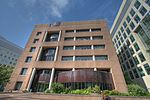MIT Radiation Laboratory
The Radiation Laboratory, commonly called the Rad Lab, was a microwave and radar research laboratory located at the Massachusetts Institute of Technology (MIT) in Cambridge, Massachusetts (US). It was first created in October 1940 and operated until 31 December 1945 when its functions were dispersed to industry, other departments within MIT, and in 1951, the newly formed MIT Lincoln Laboratory. The use of microwaves for various radio and radar uses was highly desired before the war, but existing microwave devices like the klystron were far too low powered to be useful. Alfred Lee Loomis, a millionaire and physicist who headed his own private laboratory, organized the Microwave Committee to consider these devices and look for improvements. In early 1940, Winston Churchill organized what became the Tizard Mission to introduce US researchers to several new technologies the UK had been developing. Among these was the cavity magnetron, a leap forward in the creation of microwaves that made them practical for the first time. Loomis arranged for funding under the National Defense Research Committee (NDRC) and reorganized the Microwave Committee at MIT to study the magnetron and radar technology in general. Lee A. DuBridge served as the Rad Lab director. The lab rapidly expanded, and within months was larger than the UK's efforts which had been running for several years by this point. By 1943 the lab began to deliver a stream of ever-improved devices, which could be produced in huge numbers by the US's industrial base. At its peak, the Rad Lab employed 4,000 at MIT and several other labs around the world, and designed half of all the radar systems used during the war. By the end of the war, the US held a leadership position in a number of microwave-related fields. Among their notable products were the SCR-584, the finest gun-laying radar of the war, and the SCR-720, an airborne interception radar that became the standard late-war system for both US and UK night fighters. They also developed the H2X, a version of the British H2S bombing radar that operated at shorter wavelengths in the X band. The Rad Lab also developed Loran-A, the first worldwide radio navigation system, which originally was known as "LRN" for Loomis Radio Navigation.
Excerpt from the Wikipedia article MIT Radiation Laboratory (License: CC BY-SA 3.0, Authors).MIT Radiation Laboratory
Vassar Street, Cambridge Cambridgeport
Geographical coordinates (GPS) Address Nearby Places Show on map
Geographical coordinates (GPS)
| Latitude | Longitude |
|---|---|
| N 42.3619 ° | E -71.0905 ° |
Address
Ray & Maria Stata Center (32) (Building 32)
Vassar Street 32
02139 Cambridge, Cambridgeport
Massachusetts, United States
Open on Google Maps









